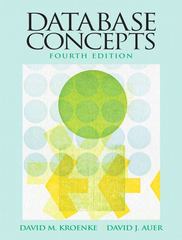Question
Please address both parts 1 and 2 of the question. Part 1 - Design pseudocode for the image comparison algorithm discussed above, given input Images
Please address both parts 1 and 2 of the question.
Part 1 - Design pseudocode for the image comparison algorithm discussed above, given input Images X, Y, and thresh. The output is a declaration: The images are similar, or The images are different.
Part 2 - Discuss the optimality of the dynamic programming solution. Discuss the time complexity of this algorithm in terms of the size of the inputs X and Y.
Design an algorithm (using pseudocode) that takes in as an input, two 2-D int arrays that are assumed to be 2 black-and-white images: initialImage x, whose dimensions are IxJ, and final image y, whose dimensions are IxK. The algorithm will compare x to the y, row-by-row, as defined below. Your algorithm will employ a dynamic programming scheme to compare X to Y identifying the minimal difference between each row.
Because you are working with black-and-white images only, you should assume that each image is a 2-D int array consisting of 2 possible values: 0 or 1, where 0 represents black and 1 represents white. Thus, this 2-D grid of 0 and 1 values comprise a 2-D black-and-white image. Each row of this image is then simply a 1-D int array filled with either 0s or 1s. Therefore, you must define how you will measure the difference between the strings of 0s and 1s in each row.
Remember that you will do the comparison one row in the images at a time.
First, compare X1,* to Y1,*. (Here X1,* is the first row in image X and Y1,* is the first row in image Y ). Next, compare X2 to Y2... Each one of these comparisons will require the construction of a D (distance) matrix.
In the following example, the first row of X is X1,*, and the first row of Y is Y1,* = 00110.

Use the following recurrence relation to develop your pseudocode:
*NOTE: There is apparently an error in the formula below, but this is what was provided by the instructor. He insists it is correct. Please clarify what is unclear or incorrect as I don't see it, or just make a reasonable assumption.

After the D matrix is completed, the minimum number in the bottom row is the minimal mismatch for this row. You will assign this value to the variable minVali. This number tells how different row X1,* is from row Y1,* . You will then repeat this comparison for all rows i and aggregate the difference when complete into variable totalDifference = Si minVali.
As a result, the algorithm will compare the total difference to a threshold value called thresh. If total value is above the threshold, the images are declared different; otherwise, they are declared to be similar images. You can assume that the thresh variable is supplied as an input to your algorithm.
Part 1 - Design pseudocode for the image comparison algorithm discussed above, given input Images X, Y, and thresh. The output is a declaration: The images are similar, or The images are different.
Part 2 - Discuss the optimality of the dynamic programming solution. Discuss the time complexity of this algorithm in terms of the size of the inputs X and Y.
X 1 2 3 4 5 1 0 011 0 2 1 1 01 Y 12 3 4 5 1 0 0 1 1 0 2 0 1 0 1 3 1 011 1 3! 1| 1| 1 Di-1,k 1],if X D(j-1, k] + 1, account for XLj not in Yk DU.k-1] + 1, account for Y.k not in X. YOR D[j- 1,k 1 1, if X Xi, Linel Line2 Line3 Lj- Yi.k D li, k] min = X 1 2 3 4 5 1 0 011 0 2 1 1 01 Y 12 3 4 5 1 0 0 1 1 0 2 0 1 0 1 3 1 011 1 3! 1| 1| 1 Di-1,k 1],if X D(j-1, k] + 1, account for XLj not in Yk DU.k-1] + 1, account for Y.k not in X. YOR D[j- 1,k 1 1, if X Xi, Linel Line2 Line3 Lj- Yi.k D li, k] min =Step by Step Solution
There are 3 Steps involved in it
Step: 1

Get Instant Access to Expert-Tailored Solutions
See step-by-step solutions with expert insights and AI powered tools for academic success
Step: 2

Step: 3

Ace Your Homework with AI
Get the answers you need in no time with our AI-driven, step-by-step assistance
Get Started


